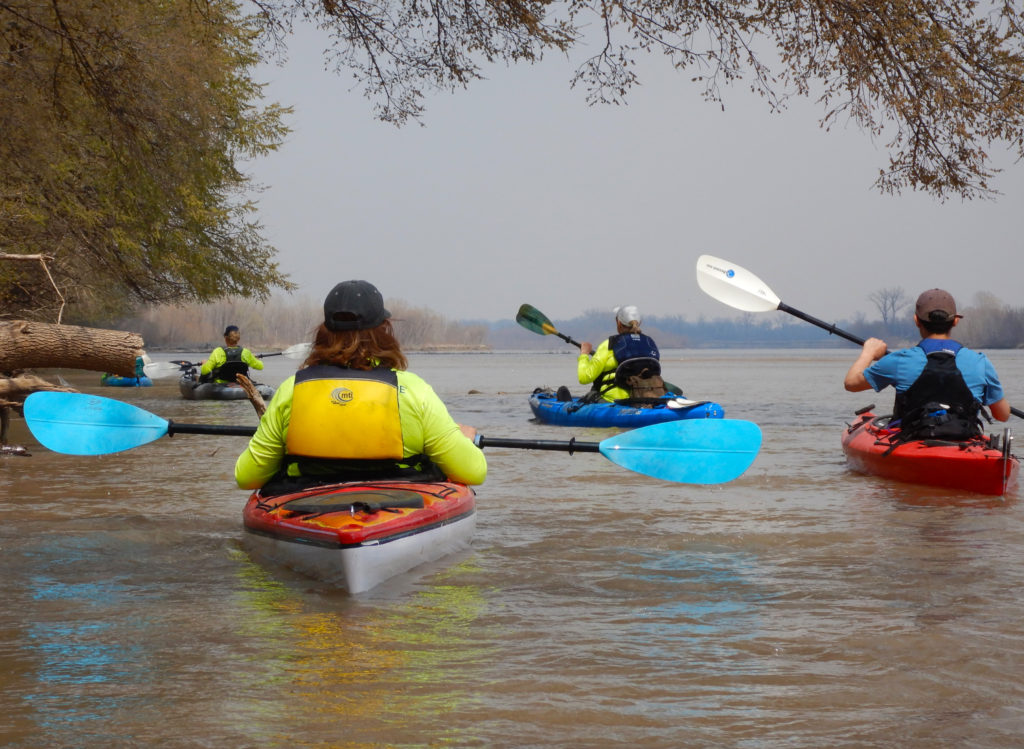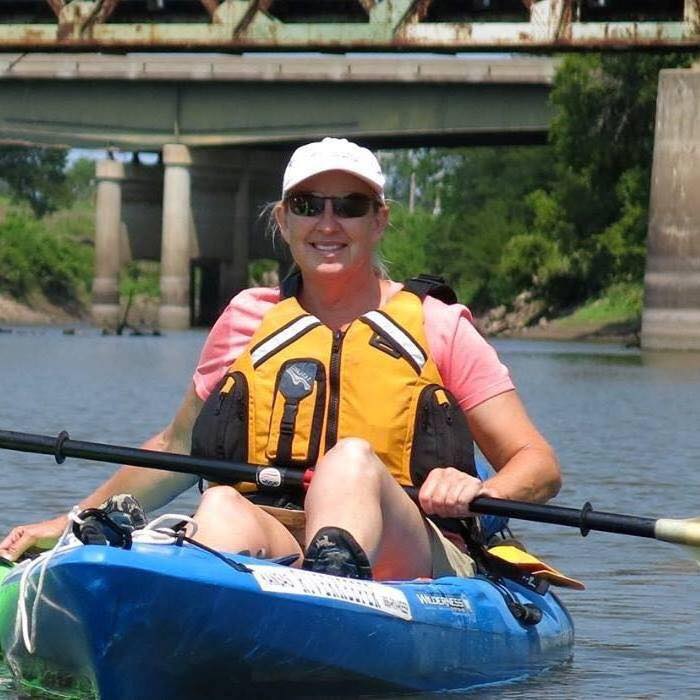
Starting Out
The best kayak for you is always the next one; you will see new features that you want, your interests may change, or you may outgrow a boat. If you don’t have a boat and use it, you won’t know what suits you. The best way to start is with a group like Friends of the Kaw or one of our river partners (https://kansasriver.org/paddle-and-fish/canoekayak-rentals/) where you can rent a boat and evaluate the fit. Look at the boats used by the regular river users and ask them “Why did you buy this boat?” Find someone your ‘size’ and ask “How does this boat fit?” Many people start in a cheap boat knowing that it’s only for a season, sell it when you either find out what you really want or when you realize kayaking is not for you, or better yet, share it with the next person that you want to bring to explore rivers. Make sure you budget for a good paddle and a good comfortable PFD.
Kayak (for the Kaw)
The wrong boat can sour you on kayaking, make paddling a chore and shuttling a nightmare. Fortunately, commercial boats are designed and certified for seaworthiness and passenger weight, so you don’t need to fret about the big things. There are advantages to every type of boat, so you have to choose what is most important to you in a boat. A few things to consider when choosing a boat:
Sit-In or Sit-On Top
Sit-In Boat: Narrower, longer, faster and will keep straight in the river’s current. More tippy, harder to get in and out of, less storage. Sit-ins must be bailed or pumped out if they take on water from rain or waves. They also tend to be lighter to carry.
Sit-On-Top Boat: Wider, slower, but more stable. Typically have more storage if you want to paddle more gear down the river. These tend have scuppers and are self-draining. They also typically are heavier.
Another item to consider is the seat. This is often overlooked as a valued amenity, but if you are sitting in the boat for a long 8 hour day it sure does help if you like the seat. It is worth sitting in one before you buy!
Length of Boat
The longer the boat, better for rivers. The shorter the boat, better for white water. The middle range is good for lakes and flat water paddling. We recommend boats over 12 feet for the Kansas River. The longer the boat, it will keep straight in the current, handle the winds and is easier to handle. That’s not to say that you must have one over 12 feet, because people kayak 10 foot kayaks all the time on the Kaw. However, this is something that you should consider when making choices. Another thing to consider is that the longer the boat, can you lift it and transport it by yourself or will you need assistance? Your Kansas Riverkeeper paddles with a 12 foot boat because it is easy to load on her own, easy to transport and still gets the job done. You have to choose what is best for you.
Stability
Wider boats will be more stable than a narrow boat. This is a trade-off since a narrow boat is easier to paddle; it has less width to push through the water. Give yourself a chance to get used to a boat before deciding it’s “too tippy” or “too slow”, our trips are 9-12 miles so it is worth learning both and deciding for yourself. The wider boat also needs a longer reach of paddle and arm to get to the water. If you have bad knees or hips, a wider sit-on top might be a good alternative. There are many things to consider!
Wind
Kansas has wind, a surprise to no one who lives here. A boat that is hard to control in the wind can make your trip miserable. Some kayaks have a rudder, or a skeg (like a fixed rudder), or a hull shape with channels to guide it straight through the water. A flat or rounded hull without channels will turn in the wind like a weathervane, all boats do this to some extent but the wrong boat takes as much effort to steer as to move forward. Wind is also a problem if your boat is too big. A big boat with a small paddler will sit high in the water. The portion above the water is known as “freeboard” and it makes an effective sail in windy conditions.
Shuttling
Somehow your boat has to get from the garage to a boat ramp. This could be by means of a trailer, on the roof of your vehicle, in the car, or in the bed of a truck. Don’t discount using a friend for a while until you decide to get serious.
Most SUVs and cars, except convertibles, can be fitted with roof racks of some sort. Kayak racks are not fitted to specific boats, so go ahead and invest in them early when you get serious about regular kayaking. Kayaks are very light as trailer loads go, so if your car has a hitch that could be an option. A trailer is another item to maintain and store.
There are folding, inflatable, and multi-part kayaks that solve the transportation problem of a small car; you may want to borrow/rent for a few trips before springing for one of these. Our trips are group affairs, and river trips should involve more than one paddler. We have to get all the boats to the launch point, get most vehicles to the take-out, get all the paddlers back to their boats, then go get the remaining vehicles from the launch at the end of the trip. In other words, we are always moving people and boats in/on whatever vehicles are available. For river trips, it’s perfectly acceptable to have “a buddy with a truck” to move your boat, especially if you volunteer to shuttle people.
What to avoid for the Kaw.
One beginner’s style that we do not recommend on the Kaw is the inflatable or pedal-powered kayaks. They don’t do well in a shallow prairie river.. The cheap ones paddle like a pool-toy and have high freeboard and inadequate skeg. Combine that with a new paddler and you have a boat that turns a 3-hour trip into 5. There certainly are suitable inflatables, but they would be the third or fourth boat that you grow into.

 Paddle safely! Use the links below to quickly access information that impacts river conditions.
Paddle safely! Use the links below to quickly access information that impacts river conditions.
